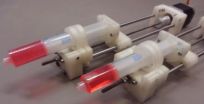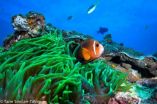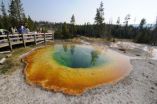(Press-News.org) At the Intelligent Transportation Systems World Congress last week, MIT researchers received one of the best-paper awards for a new system, dubbed RoadRunner, that uses GPS-style turn-by-turn directions to route drivers around congested roadways.
In simulations using data supplied by Singapore's Land Transit Authority, the researchers compared their system to one currently in use in Singapore, which charges drivers with dashboard-mounted transponders a toll for entering congested areas.
The Singapore system gauges drivers' locations with radio transmitters mounted on dozens of gantries scattered around the city, like the gantries used in many U.S. wireless toll systems. RoadRunner, by contrast, uses only handheld devices clipped to cars' dashboards. Nonetheless, in the simulations, it yielded an 8 percent increase in average car speed during periods of peak congestion.
Moreover, for purposes of comparison, the MIT researchers restricted themselves to road-access patterns dictated by Singapore's existing toll system. Modifying those patterns — encouraging or discouraging the use of different stretches of road — could, in principle, lead to even greater efficiency gains.
"With our system, you can draw a polygon on the map and say, 'I want this entire region to be controlled,'" says Jason Gao, a graduate student in electrical engineering and computer science who developed the new system together with his advisor, Professor of Electrical Engineering and Computer Science Li-Shiuan Peh. "You could do one thing for a month and test it out and then change it without having to dig up roads or rebuild gantries."
Gao and Peh also tested their system on 10 cars in Cambridge, Mass. Of course, 10 cars is not enough to dramatically affect local traffic patterns. But it was enough to evaluate the efficiency of the communications system and of the vehicle-routing algorithm. It also provided reliable data about the system's performance for use in simulations.
Max capacity
Urban toll systems like the one in Singapore designate certain regions — with gantries at every entry point — as prone to congestion. Drivers are charged a fee for entering any such region, so they have an incentive to avoid it. The fee fluctuates over the course of the day, according to historical traffic data.
RoadRunner, by contrast, assigns each such region a maximum number of cars. Any car entering the region must acquire a virtual authorization that Gao and Peh call a "token." If no tokens are free, RoadRunner routes the car around the region using turn-by-turn voice prompts.
The version of RoadRunner used in the Cambridge tests was largely decentralized: A car leaving a region would wirelessly announce that its token was available, and a car seeking to enter the region would request it. The system used a wireless standard called 802.11p, a variation on Wi-Fi that uses a narrower slice of the electromagnetic spectrum but is licensed for higher-power transmissions, so that it has a much larger broadcast range.
It could be that the time savings promised by RoadRunner would be enough to induce commuters to use it. But it would also be possible to modify the system so that any car entering a congestion-prone region without a token would be assessed a small fine.
Reporting a car for tokenless entry would require uploading data to a central server, but it wouldn't require specifying the car's location at a resolution finer than that of the region. So Gao believes that, even though RoadRunner relies on GPS data, it wouldn't compromise drivers' privacy any more than existing urban toll systems do. In fact, he argues, it would compromise privacy less, since cars that followed the system's routing instructions would never have their locations reported.
An app for that
In their experiments, Gao and Peh used cellphones to control commercial 802.11p radios, which are about the size of a typical electronic-toll dashboard transponder. But in the future, it may be possible to embed the radios directly into cellphones.
At the International Symposium on Low Power Electronics and Design in August, Gao, Peh, and lead author Pilsoon Choi, a postdoc in Peh's group, together with researchers at Nanyang Technological University in Singapore, presented a paper demonstrating that an 802.11p radio built from gallium nitride and controlled by silicon electronics would consume half the power that existing radios do.
Moreover, the Singapore-MIT Alliance for Research and Technology (SMART) has developed a technique for integrating gallium nitride into existing silicon-chip manufacturing processes and is currently building a chip-fabrication facility to implement it.
"In Singapore, the government already requires every single registered vehicle to have a dash-mounted transponder," Gao says. "That's already there, so you might as well take advantage of it. In other places, where you don't have that in place, it would be easier to deploy it if you said, 'You can download this app and just leave your cellphone on your dashboard.'"
INFORMATION:
Written by Larry Hardesty, MIT News Office
RELATED LINKS
Paper: "RoadRunner: Infrastructure-less Vehicular Congestion Control."
Jason Gao
Peh Group
Archive: Eliminating unexplained traffic jams
Archive: Sharing data links in networks of cars
Reducing traffic congestion with wireless system
System that would wirelessly route drivers around congested roadways wins best-paper award
2014-09-17
ELSE PRESS RELEASES FROM THIS DATE:
NASA sees Odile soaking Mexico and southwestern US
2014-09-17
Tropical Storm Odile continues to spread moisture and generate strong thunderstorms with heavy rainfall over northern Mexico's mainland and the Baja California as well as the southwestern U.S. NASA's Tropical Rainfall Measuring Mission or TRMM satellite measured rainfall rates from space as it passed over Odile.
Odile had weakened to a tropical storm with winds of about 55 knots (63.3 mph) when the TRMM satellite flew over on September 16, 2014 at 0917 UTC (2:19 a.m. PDT). Odile was still well organized and TRMM's Precipitation Radar (PR) measured rain falling at a rate ...
Doing science just got cheaper -- and faster
2014-09-17
Furnishing a research lab can be pretty expensive. Now a team led by an engineer at Michigan Technological University has published an open-source library of designs that will let scientists slash the cost of one commonly used piece of equipment: the syringe pump.
Syringe pumps are used to dispatch precise amounts of liquid, as for drug delivery or mixing chemicals in a reaction. They can also cost hundreds or even thousands of dollars.
Joshua Pearce and his team of Michigan Tech students published the library of free syringe-pump designs, which anyone can make on a ...
The future of global agriculture may include new land, fewer harvests
2014-09-17
Climate change may expand suitable cropland, particularly in the Northern high latitudes, but tropical regions may becoming decreasingly suitable, according to a study published September 17, 2014 in the open-access journal PLOS ONE by Florian Zabel from Ludwig Maximilians University, Germany and colleagues.
Most of the Earth's accessible agricultural land are already under cultivation. Ecological factors such as climate, soil quality, water supply and topography determine the suitability of land for agriculture. Climate change may impact global agriculture, but some ...
Nemo's epic journey to find a new home
2014-09-17
New research has found clownfish larvae can swim up to 400 kilometres in search of a home, which makes them better able to cope with environmental change.
Clownfish spend their entire adult lives under the protection of their host anemone but as babies they must wander the open ocean, says study co-author, Dr Hugo Harrison from the ARC Centre of Excellence for Coral Reef Studies (Coral CoE) at James Cook University.
"In the past we haven't known where they go, but now we've been given a rare glimpse into how far they can swim, crossing large tracts of ocean to find ...
Blood test could identify when cancer treatment has become detrimental
2014-09-17
Some treatments for prostate cancer, while initially effective at controlling the disease, not only stop working over time but actually start driving tumour growth, a major new study shows.
Researchers identified the emergence of drug-resistant cancer cells by testing repeated blood samples from patients with advanced prostate cancer.
They set out a new 'treatment paradigm' – the constant monitoring of patients using a blood test for signs that therapy is becoming counter-productive.
The study was conducted at The Institute of Cancer Research, London, The Royal Marsden ...
Expedition finds Nemo can travel great distances to connect populations
2014-09-17
Clownfish spend their entire lives nestling in the protective tentacles of host anemones, but new research shows that as babies they sometimes travel hundreds of kilometres across the open ocean. Although the process of long-distance dispersal by reef fish has been predicted, this is the first time that the high level exchange of offspring between distant populations has been observed.
Dr Steve Simpson, Senior Lecturer in Marine Biology and Global Change at the University of Exeter, and colleagues from the Australian Research Council Centre of Excellence for Coral Reef ...
Study links physical activity in older adults to brain white-matter integrity
2014-09-17
CHAMPAIGN, Ill. — Like everything else in the body, the white-matter fibers that allow communication between brain regions also decline with age. In a new study, researchers found a strong association between the structural integrity of these white-matter tracts and an older person's level of daily activity – not just the degree to which the person engaged in moderate or vigorous exercise, but also whether he or she was sedentary the rest of the time.
The study, reported in the journal PLOS ONE, tracked physical activity in 88 healthy but "low-fit" participants aged 60 ...
Targeted radiation, drug therapy combo less toxic for recurrent head, neck cancers
2014-09-17
SAN FRANCISCO, Sept. 17, 2014 – Patients with a recurrence of head and neck cancer who have previously received radiation treatment can be treated more quickly, safely and with fewer side effects with high doses of targeted radiation known as Stereotactic Body Radiation Therapy (SBRT) in combination with a drug that also carefully targets cancerous tumors. These findings from a UPMC CancerCenter study were presented today at the American Society of Radiation Oncology (ASTRO) annual meeting in San Francisco.
SBRT uses concentrated radiation beams in high doses to destroy ...
Nature's designs inspire research into new light-based technologies
2014-09-17
BELLINGHAM, Washington, USA -- "Nature has developed, very cleverly, some lessons on how to create the features that we desire in optical design," said Joseph Shaw, director of the Optical Technology Center at Montana State University. "As we explore surfaces and structures at the nanoscale, we'll discover them."
Some of those lessons were presented in San Diego in August during a conference called "The Nature of Light: Light in Nature" chaired by Shaw and Rongguang Liang of the University of Arizona College of Optical Sciences. The conference was part of SPIE Optics ...
In Joslin trial, Asian Americans lower insulin resistance on traditional diet
2014-09-17
BOSTON – September 17, 2014 – Why are Asian Americans at higher risk of developing type 2 diabetes than Caucasian Americans, and prone to develop the disease at lower body weights? One part of this puzzle may lie in the transition from traditional high-fiber, low-fat Asian diets to current westernized diets, which may pose extra risks for those of Asian heritage, says George King, M.D., Senior Vice President and Chief Scientific Officer at Joslin Diabetes Center and the senior author of the study.
A Joslin randomized clinical trial now has demonstrated that both Asian ...
LAST 30 PRESS RELEASES:
Archaeologists use AI to create prehistoric video game
Mitochondria migrate toward the cell membrane in response to high glucose levels
Tiny viral switch offers hope against drug-resistant bacteria
Most parents aware of early peanut introduction guidelines, but confused about details
HPV vaccine can protect against severe lesions of the vulva and vagina
Virtual care provision and emergency department use among children and youth
Quadrivalent HPV vaccine and high-grade vulvovaginal lesions
Insights into dry eyes gained from stem cell-derived tear glands
Researchers identify 166 human pluripotent stem cell lines available for use in clinical applications
Europa Clipper instrument uniquely observed interstellar comet 3I/ATLAS
UN University Report challenges climate change as sole trigger of Syrian Civil War, exposing governance failures in drought response
Real estate investment trust (REIT) acquisition associated with hospital closure and bankruptcy
New Raman imaging system detects subtle tumor signals
Boston Children’s receives a $7.5 million grant from Aligning Research to Impact Autism (ARIA) to provide clinical research coordination for the IMPACT Network
Spray-on antibacterial coating offers new protection for plants against disease and drought
ESMT Berlin study: What makes a first offer successful in negotiations
Groundbreaking ceremony marks the beginning of CTAO-South Array construction in Chile
Why swearing makes you stronger
What prevents more cancer patients from enrolling in potentially life-saving clinical trials?
UK’s worst-case climate risks laid bare for lawmakers
A decline in churchgoing linked to more deaths of despair
TAMEST announces Maralice Conacci-Sorrell, Ph.D., UT Southwestern Medical Center, as 2026 Mary Beth Maddox Award & Lectureship Recipient
Global study to evaluate whether dengue outbreaks can be anticipated earlier
Chonnam National University researchers propose innovative voltage-loop control for power factor correction
Accelerating next-generation drug discovery with click-based construction of PROTACs
Detecting the hidden magnetism of altermagnets
$7M gift supports health research, engineering and athletics at UT San Antonio
NU-9 halts Alzheimer’s disease in animal model before symptoms begin
Hospitals acquired by real estate investment trusts associated with greater risk of bankruptcy, closure
City of Hope scientists study rare disorder to uncover mechanism and hormone regulation underlying fatty liver disease and sweet aversion
[Press-News.org] Reducing traffic congestion with wireless systemSystem that would wirelessly route drivers around congested roadways wins best-paper award





